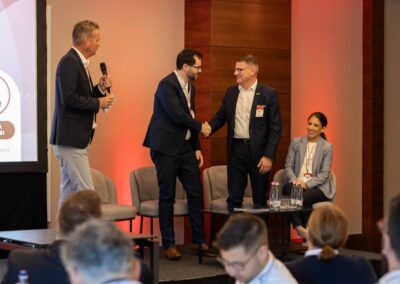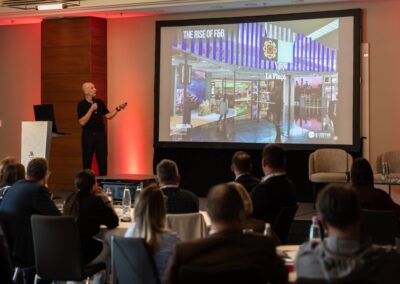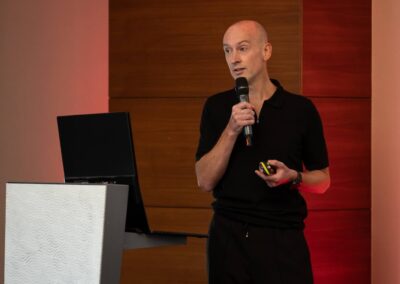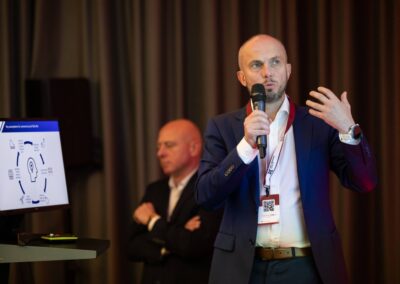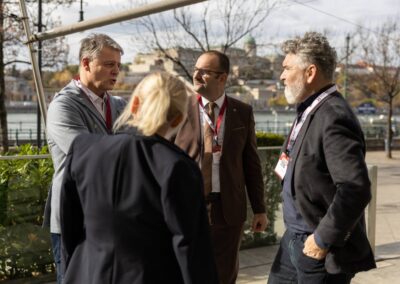Budapest, 30 October 2025
This year’s CEETRA Travel Retail Forum in Budapest – opened by Andrzej Miłaszewicz (CEETRA) in the welcome speeches session and framed by the keynote The state of the industry in Europe, with a special focus on Central & Eastern Europe by Peter Mohn – made one thing very clear: airports in Central and Eastern Europe are no longer just transport hubs. They are becoming independent economic and cultural spaces. An airport is no longer just a waiting area, but a commercial platform with its own revenue model, spatial logic, and tone of voice to the passenger. The growing weight of non-aeronautical revenues – retail, F&B, parking, services – is now defining airport profitability. At several regional airports these revenue streams already account for most of total turnover, effectively turning the terminal itself into a business product.
According to the Changing Consumer Behaviour & Spending Patterns panel discussion moderated by Peter Mohn with Wojciech Czernek (CEO, Baltona), Razvan Horga (CEO, Oradea Airport, Romania), and Bianka Pivarcsi (Head of Marketing, Budapest Airport), the biggest commercial upside in the next few years is in small and mid-sized airports. These airports sit in competitive catchment areas where passengers can easily choose an alternative within driving distance. That means every traveler has to be won, not assumed. Under these conditions it’s no longer enough to rent out a few retail units and hope for the best. The commercial concept has to be built into the terminal from day one. Done properly, this raises revenue per square meter, stabilizes operations, and in some cases doubles per-passenger spend versus the old fragmented model. In other words: an airport in 2025 is not just infrastructure serving airlines. It is a brand.
A recurring point in Budapest was that the passenger has changed – and that change is reshaping how airports are run. Airports in Central and Eastern Europe now have to meet two opposing expectations at the same time. One side is the younger traveler, who expects instant self-service, zero friction, and fully contactless payment. The other is the traveler who wants human presence, visible assistance, and reassurance, not just speed. These needs do not replace each other; they coexist at the same gate. As a result, airport operations are being forced into a dual model: one layer must be fast, digital, queue-free; the other must be staffed, personal, and physically present. This is not positioned as a premium extra. It is now seen as a baseline. If either layer is missing, the passenger leaves frustrated — and does not return.
Payments have shifted in parallel. Travel and Payment Intentions in CEE, Visa Study 2025, presented by Katarzyna Zubrzycka (VISA), underlined that travel is still a top spending priority in the region, but the way people spend has changed. Most passengers now set a personal budget before departure and actively track every cost in real time through mobile banking. Cross-border spend is primarily card or digital wallet. There is a clear expectation that every payment touchpoint in the journey – duty free, dining, ground transport, tickets – must be instant, contactless, transparent. The ask from the traveler is no longer “give me a good card,” it’s “give me a full travel finance ecosystem”: multicurrency accounts, bundled transport and accommodation offers, insurance, and clean FX conversion. Travel has become not just logistics, but a live financial project the passenger manages themselves.
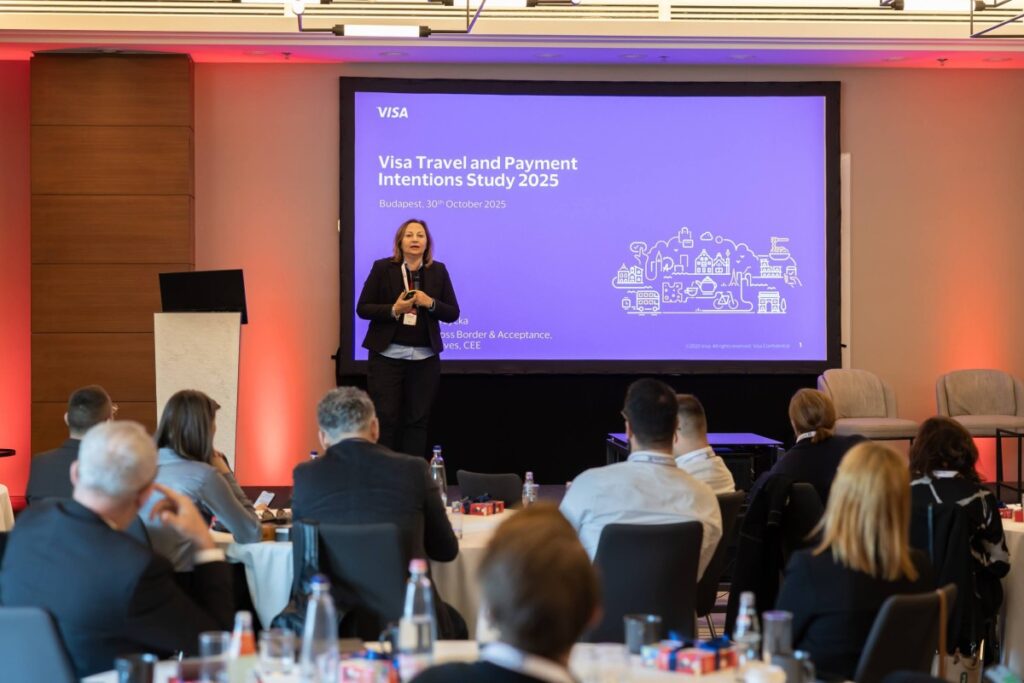
One key theme was sense of place. Sense of Place 2.0 – Local Identity and Innovative Design as a Passenger Magnet, presented by Nick Taylor (The Design Solution), argued that an airport can no longer be a neutral box that could be anywhere. The commercial and service environment now has to visibly reflect the identity of the city and country. This is not only branding. When a terminal feels specific, local, and recognisable, passengers are more willing to spend because what they buy feels like part of the trip, not just a transaction. In that sense, the terminal becomes the first or last sentence a city says to a traveler.
The wider commercial context – captured in Opportunities for Brands in Travel Retail, moderated by Csaba Simonidesz (Simillair) with Maciej Adamaszek (True), Bence Biró (Heinemann Budapest), and Zoltán Keresztessy (CEO, Klikkmánia) is that airports in Central and Eastern Europe now act like brands competing for loyalty in real time. The passenger expects high-speed digital autonomy and, at the same moment, visible human care. Loyalty is not assumed; it has to be earned on the spot. And factors once seen as “nice to have” – accessibility, local identity, payment transparency – are now basic conditions for doing business in this region.
Smart Commercial Strategies for Small & Medium Airports focused on one main point: for a smaller airport, financial performance isn’t defined by passenger volume, but by how intelligently it builds its own commercial model. Krzysztof Domagalski (Szczecin Airport) highlighted three factors that actually matter: first, whether the airport runs retail in-house or outsources it; second, how intentionally the terminal space is laid out from a commercial point of view — meaning, how the passenger is guided through the shops; and third, whether the data on passenger behavior is really used to make decisions, instead of just ending up in reports. The conclusion was straightforward: if these pieces are designed well, even a mid-sized regional airport can operate like a deliberately built retail brand and generate measurably higher spend per passenger.
Accessibility – physical, sensory, and informational – was positioned as a core business requirement, not a CSR add-on. The Inclusive Journey: Designing Accessible Travel and Retail Spaces at Airports, presented by Jarosław Bogucki (Integracja Foundation), made the case that an airport is not built for a single imaginary “average passenger,” but for people who arrive with very different bodies and sensory thresholds. The expectation is that a passenger with reduced mobility, an elderly traveler, a person on the autism spectrum or with sensory sensitivity, and a family with a small child can all move through the terminal safely and with a clear mental map. In practice this means step-free routes, tactile and visual wayfinding, designated low-noise / low-light areas, longer escort options at key arrival points, and immediate access to alternative communication channels. The message was explicit: this is both inclusion and revenue. People stay longer and spend more calmly if they feel safe, oriented, and in control.

The CPK Commercial Strategy talk showed how CPK thinks as a completely new, greenfield hub airport: it’s not that you first build a terminal and only then figure out retail — it’s the other way around. The commercial, service, and brand experience is part of the floor plan from the first sketch. According to Paweł Zagrajek, CPK is not an airport in the classic sense, but an integrated commercial ecosystem in which passenger flow, retail, F&B, digital services, and payment logic are conceived as one plan. This means the airport will behave like a standalone international brand from day one: it doesn’t just want to be a transit point into Poland, but the first sentence of the place’s identity — with a controlled tempo, high revenue potential, and zero compromise.
In closing, CEETRA’s 2025 Travel Retail Forum in Budapest made it clear that Central and Eastern Europe is not a secondary market anymore. It is a testbed. Airports here are treating commercial space, payment infrastructure, brand experience, accessibility, and sense of place as core strategy — not support functions. The message from was consistent: in this region, the airport is no longer just where travel happens. It is the product.




